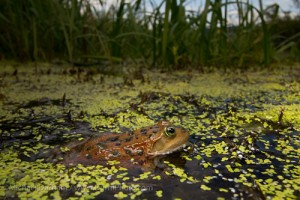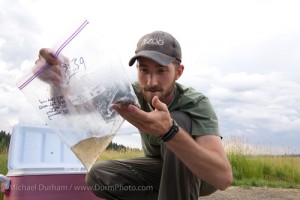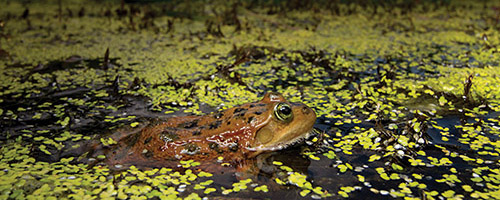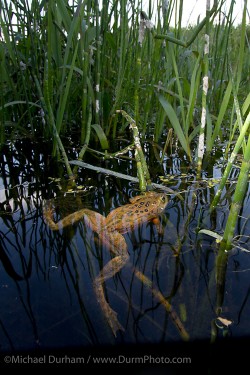Knee deep in Washington’s cold marshland waters, Kyle Tidwell catches frogs and records habitat data. It isn’t what most people would consider an ideal way to spend a Saturday morning. But to Tidwell, a Portland State graduate student, it’s paradise.
Invasive bullies

COURTESY OF MIchael Durham
THE OREGON SPOTTED FROG—pictured here in the Conboy Lake National Wildlife Refuge in Washington—is fighting for its survival.
Knee deep in Washington’s cold marshland waters, Kyle Tidwell catches frogs and records habitat data. It isn’t what most people would consider an ideal way to spend a Saturday morning.
But to Tidwell, a Portland State graduate student, it’s paradise.
As a conservation biologist researcher, Tidwell divides his time between the field and his office at the Oregon Zoo, where he studies amphibian behavior. His doctoral research focuses on the impact of the vastly invasive American bullfrog on the local—and endangered—Oregon spotted frog. He’s collecting clues to help solve a decades-long mystery: What role does the American bullfrog play in the decline of the Oregon spotted frog population?
In recent years, Oregon spotted frog numbers in the Pacific Northwest have dwindled. The frog now inhabits less than 15 percent of its original range, in part because of competition with invasive predator species such as bullfrogs. The bullfrog—a frog of superior size, weight and speed compared to the Oregon spotted frog—will feed on anything that can fit in its mouth, putting the tinier, slower spotted frog high on the bullfrog’s menu.

Courtesy of MIchael Durham
Kyle Tidewell, a PSU graduate student, catches frogs and records habitat data.
According to Tidwell, bullfrogs have been affecting native frog populations for over 70 years, and currently thrive in every location where Oregon spotted frogs have gone extinct. This has prompted institutions like the Oregon Zoo to begin raising the endangered species in captivity for the
purpose of reintroducing them into the wild at locations with stable habitats—and hopefully no bullfrogs.
Despite this bleak scenario of frog against frog in an unevenly matched fight for an already limited habitat, there is some hope. The only location in the world where Oregon spotted frogs manage to coexist with bullfrogs is at Conboy Lake National Wildlife Refuge in Washington.
The refuge covers more than 6,500 acres of pristine forests and wetlands. Managed by the Washington Department of Fish and Wildlife, this gem of the Pacific Northwest also acts as a safe haven for bald eagles and the endangered greater sandhill crane. “It’s a unique privilege to work with Oregon spotted frogs at Conboy Lake. The refuge is a beautiful place,” said Tiffany Hicks, a biologist for the WDFW.
If Tidwell can discover what aspect of Conboy Lake’s Oregon spotted frog population makes them successful, then perhaps those conditions can be replicated in other locations.
To uncover how Conboy’s Oregon spotted frogs are surviving, Tidwell has devised a series of inventive experiments that mimic predator approach.
One test involves dropping a foam ball from above a frog’s head, not allowing it to hit them, but close enough to elicit an escape response. He records and compares the response times of two populations of Oregon spotted frogs: one from Conboy Lake and one from Black River, where bullfrogs have remained absent. But since a foam ball is not a predator of the Oregon spotted frog, Tidwell decided to get more creative.
“If I think that the bullfrog is the thing that is causing them to go extinct, I need to throw a bullfrog at them, metaphorically,” Tidwell said.
Using a replica bullfrog head attached to the front end of a Thomas the Train children’s toy, Tidwell is able to push the fake bullfrog toward his test subjects, making for a more realistic renactment of a predator scenario. While the frogs from Conboy did have faster reaction times, Tidwell admits, “What I’m finding preliminarily is that they are not recognizing the invasive predator.” He tested 353 frogs this summer.
Tidwell thinks that the Oregon spotted frog has evolved to survive by remaining camouflaged in the face of a native predator—hoping to go unseen—allowing it to get very close before jumping away to safety at the last second. However, when pitted against a larger, much faster species, allowing it to get close before attempting escape isn’t ideal.
“If several thousand years of selection resulted in a successful anti-predator behavior for the Oregon spotted frog, and we now have an introduced species that acts in a different way, then perhaps selection has dealt the Oregon spotted frog a bad hand by making them respond in a way that is deleterious to their survival in the wild,” Tidwell said.
Understanding the consequences of this survival trait becomes even more important when rear-and-release programs like the one at the Oregon Zoo are reintroducing frogs that have spent most of their lives in a threat-free environment into the wild. If wild Oregon spotted frogs have fallen prey to bullfrogs because of poor recognition and slow escape responses, then captive-raised frogs stand even less of a chance once released.
If Oregon spotted frogs are reacting too slowly to avoid bullfrogs, the next step is to determine how much of an impact the bullfrog has—essentially, determining how much Oregon spotted frog the bullfrogs are eating.
“We have found Oregon spotted frogs in the stomachs of bullfrogs. At every site where Oregon spotted frogs have gone extinct, bullfrogs now inhabit—but is that causation or correlation?”
Tidwell said.
This means further study is required. While collecting crucial habitat data surrounding the ecological outlier that is Conboy Lake, and further studying the predator avoidance behavior of the Oregon spotted frog, Tidwell continues to collaborate with the Oregon Zoo.
By raising Oregon spotted frogs for release, the zoo gives the species another chance at survival. With ecological management tools from Tidwell’s research, one day their populations may become self-sustaining. “In zoos we have an ethical imperative to maximize the well-being of the animals in our care,” said David Shepherdson, conservation division manager at the Oregon Zoo. “This extends out to those animals that take part in species recovery conservation
programs.”
“If we lose amphibians…we are going to lose all of the secrets that they have to offer,” Tidwell said. “You like medicine? You like antibiotics? Then you like herptofauna. Antifungals, antimicrobials, peptides, enzymatic function that we have barely tapped, that natives around the world already understand, come from herptofauna—someone has to save them.”






After reading about Kyle Tidwell and the spotted frog I wondered if this frog or similar has turned up at my old home pluace in Evans Valley, out of Rogue River. I grew up there hearing the regular little frogs but on a visit back in April, 2012, I could not believe the loud voices at night. Definitely not the little voices I use to hear. my friend did get a picture of one but it is not real clear. I could probably get the picture from her.
I’ve been puzzled over the loud voice frogs every since.
Thank you.
Phyllis Haynes